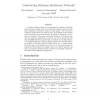Free Online Productivity Tools
i2Speak
i2Symbol
i2OCR
iTex2Img
iWeb2Print
iWeb2Shot
i2Type
iPdf2Split
iPdf2Merge
i2Bopomofo
i2Arabic
i2Style
i2Image
i2PDF
iLatex2Rtf
Sci2ools
COMGEO
2008
ACM
2008
ACM
Constructing minimum-interference networks
A wireless ad-hoc network can be represented as a graph in which the nodes represent wireless devices, and the links represent pairs of nodes that communicate directly by means of radio signals. The interference caused by a link between two nodes u and v can be defined as the number of other nodes that may be disturbed by the signals exchanged by u and v. Given the position of the nodes in the plane, links are to be chosen such that the maximum interference caused by any link is limited and the network fulfills desirable properties such as connectivity, bounded dilation or bounded link diameter. We give efficient algorithms to find the links in two models. In the first model, the signal sent by u to v reaches exactly the nodes that are not farther from u than v is. In the second model, we assume that the boundary of a signal's reach is not known precisely and that our algorithms should therefore be based on acceptable estimations. The latter model yields faster algorithms.
| Added | 09 Dec 2010 |
| Updated | 09 Dec 2010 |
| Type | Journal |
| Year | 2008 |
| Where | COMGEO |
| Authors | Marc Benkert, Joachim Gudmundsson, Herman J. Haverkort, Alexander Wolff |
Comments (0)

